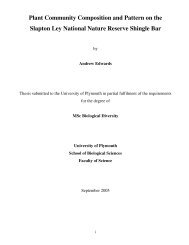de Vere 2007 Biol Flora C. dissectum.pdf - The Whitley Wildlife ...
de Vere 2007 Biol Flora C. dissectum.pdf - The Whitley Wildlife ...
de Vere 2007 Biol Flora C. dissectum.pdf - The Whitley Wildlife ...
- No tags were found...
You also want an ePaper? Increase the reach of your titles
YUMPU automatically turns print PDFs into web optimized ePapers that Google loves.
880N. <strong>de</strong> <strong>Vere</strong>© <strong>2007</strong> <strong>The</strong> AuthorJournal compilation© <strong>2007</strong> BritishEcological Society,Journal of Ecology,95, 876–894unique to Ireland, the characteristic species beingSchoenus nigricans, Cirsium <strong>dissectum</strong>, Anagallis tenellaand Hydrocotyle vulgaris. White & Doyle (1982) <strong>de</strong>scribethe association as wi<strong>de</strong>spread throughout Ireland andIvimey-Cook & Proctor (1966) found it to be the mostwi<strong>de</strong>spread and characteristic fen type in the Burren,especially in the low-lying limestone country in theeastern part of the area. <strong>The</strong> most constant specieswere: Agrostis stolonifera, Carex hostiana, Carex panicea,Cirsium <strong>dissectum</strong>, Mentha aquatica, Molinia caerulea,Potentilla erecta, Schoenus nigricans, Succisa pratensis,Aneura pinguis, Campylium stellatum, Drepanocladusrevolvens sensu lato, Fissi<strong>de</strong>ns adianthoi<strong>de</strong>s and Scorpidiumscorpioi<strong>de</strong>s. O’Criodain & Doyle (1997) do not supportthe Cirsio dissecti-Schoenetum nigricantis associationas <strong>de</strong>fined by Braun-Blanquet & Tüxen (Ir. Pfl.) andplace this community in Ireland within the Schoenetumnigricantis Allorge 1922. <strong>The</strong>y <strong>de</strong>fine a new sub association,the Cirsietosum dissecti, that comprises vegetationfrom the driest of habitats for Schoenus nigricans.In Ireland, Cirsium <strong>dissectum</strong> is sometimes found onthe edges of turloughs, growing with Carex panicea, Carexhostiana, Carex flacca, Molinia caerulea and Succisapratensis on nutrient poor fens, often on skeletallimestone, or with Schoenus nigricans, Molinia caerulea,Achillea ptarmica and Parnassia palustris in areas where alayer of fen peat is usually present (Goodwillie 2003); itis not, however, a characteristic turlough species.<strong>de</strong> <strong>Vere</strong> (<strong>2007</strong>) surveyed 11 sites in England andWales to examine the range of communities in whichC. <strong>dissectum</strong> was found. Sites were chosen that appearedto represent the greatest amount of variation in communitytype. Ten 2 × 2 m quadrats were surveyed ateach site during July or August, and MAVIS PlotAnalyser v. 1 (Smart 2000) and Rodwell (1991, 1995,2000) used to assign the sites to National VegetationClassification (NVC) communities (Table 2). Detren<strong>de</strong>dCorrespondance Analysis (DCA) was carried out(Fig. 3) to examine the relationships between quadratsand sites using the program DECORANA within the CommunityAnalysis Package 2.15 (Pisces Conservation,2003). Three broad groups emerged when all 11 siteswere inclu<strong>de</strong>d in the analysis: (i) SD14b and SD14d(Salix repens–Campylium stellatum dune-slack, Rubuscaesius–Galium palustre and Festuca rubra subcommunities),(ii) S24c (Phragmites australis–Peucedanumpalustre tall-herb fen, Symphytum officinale subcommunity)and (iii) the remain<strong>de</strong>r of sites that consisted ofM16b (Erica tetralix–Sphagnum compactum wet heath,Succisa pratensis–Carex panicea subcommunity) andM24c (Molinia caerulea–Cirsium <strong>dissectum</strong> fen meadow,Juncus acutiflorus–Erica tetralix subcommunity).When the dune-slack and tall-herb fen communitieswere removed, the M16b and M24c sites showed somedifferentiation but still overlapped within the ordinationplot. Rodwell (1991, 1995, 2000) does not inclu<strong>de</strong> Cirsium<strong>dissectum</strong> within the SD14 community and, in additionto the M24, M16 and S24 communities, inclu<strong>de</strong>s C.<strong>dissectum</strong> within the M21 Narthecium ossifragum-Fig. 3 Detren<strong>de</strong>d Correspon<strong>de</strong>nce Analysis of sites whereCirsium <strong>dissectum</strong> is present. Each point represents a singlequadrat. See Table 2 for a <strong>de</strong>scription of the 3 letter site co<strong>de</strong>sshown. <strong>The</strong> shape of each point represents a NationalVegetation Classification community: squares M24c; squarescontaining a star M24; triangles M16b; closed circles SD14b;open circles SD14d; dashes S24c. (a) Analysis of all 11 sitessurveyed. (b) <strong>The</strong> same analysis with the SD14b, SD14d andS24c communities removed.Sphagnum papillosum valley mire, M22 Juncus subnodulosus-Cirsiumpalustre fen-meadow, M13 Schoenusnigricans-Juncus subnodulosus mire and M29 Hypericumelo<strong>de</strong>s-Potamogeton polygonifolius soakway communitiesand subcommunities.Blackstock et al. (1998) surveyed 50 wet grasslandsites in lowland Wales and examined edaphic andfloristic characteristics within them. <strong>The</strong>y suggested anadditional subcommunity called the Welsh nodum(M24x) within the M24 community to cover standsthat had a poor representation of preferentials for theexisting subcommunity types. Three variants of M24xwere <strong>de</strong>scribed with C. <strong>dissectum</strong> occurring in two ofthese. When Yeo et al. (1998) surveyed 114 remnantstands of neutral and acidic dry grasslands and wetpastures in mid-Wales, Cirsium <strong>dissectum</strong> was mostfrequent in M24b Molinia caerulea–Cirsium <strong>dissectum</strong>fen meadow, typical subcommunity, M24c and M24x,but small populations were also recor<strong>de</strong>d from a rangeof other community types.IV. Response to biotic factors(A) GRAZINGCirsium <strong>dissectum</strong> has soft prickles on its leaves butthese do not form an effective grazing <strong>de</strong>terrent:




